Досвід використання платформи 3DEXPERIENCE
Для ознайомлення вийшла публікація во французському журналі "Дассаулт Системс".
Для ознайомлення вийшла публікація во французському журналі "Дассаулт Системс".
Адреса приймальної комісії
КПІ ім. Ігоря Сікорського: вул. Політехнічна, 14, корпус 16, м. Київ
Розклад роботи Приймальної комісії КПІ ім. Ігоря Сікорського та Етапи вступної кампанії
Телефони для довідок:
+38 (044) 204-96-45,
+38 (044) 204-96-46
Контактна інформація ПК https://pk.kpi.ua/contacts/
E-mail: This email address is being protected from spambots. You need JavaScript enabled to view it.
E-mаіl: This email address is being protected from spambots. You need JavaScript enabled to view it.
Телефон гарячої лінії ММІ: +38 (097) 131-85-65
Адреса для іноземних громадян:
Київ, вул. Металістів, 5А
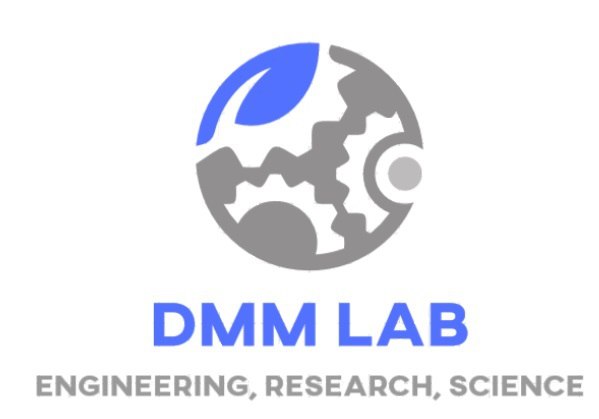 |
«Експериментальні дослідження нових матеріалів та біомеханічних систем» |
|
Керівник – к.т.н., ст.н.с. Шидловський Микола Сергійович Викладачі – Фам Дик Куан, Мусієнко Ольга Станіславівна |
|
|
Контакти: Соціальні мережі: |
|
Тематика роботи
- дослідження механічних властивостей кісткових та м’язових тканин
- дослідження нових матеріалів для імплантатів
- удосконалення засобів фіксації переломів кісток
- удосконалення засобів імплантації суглобів кінцівок
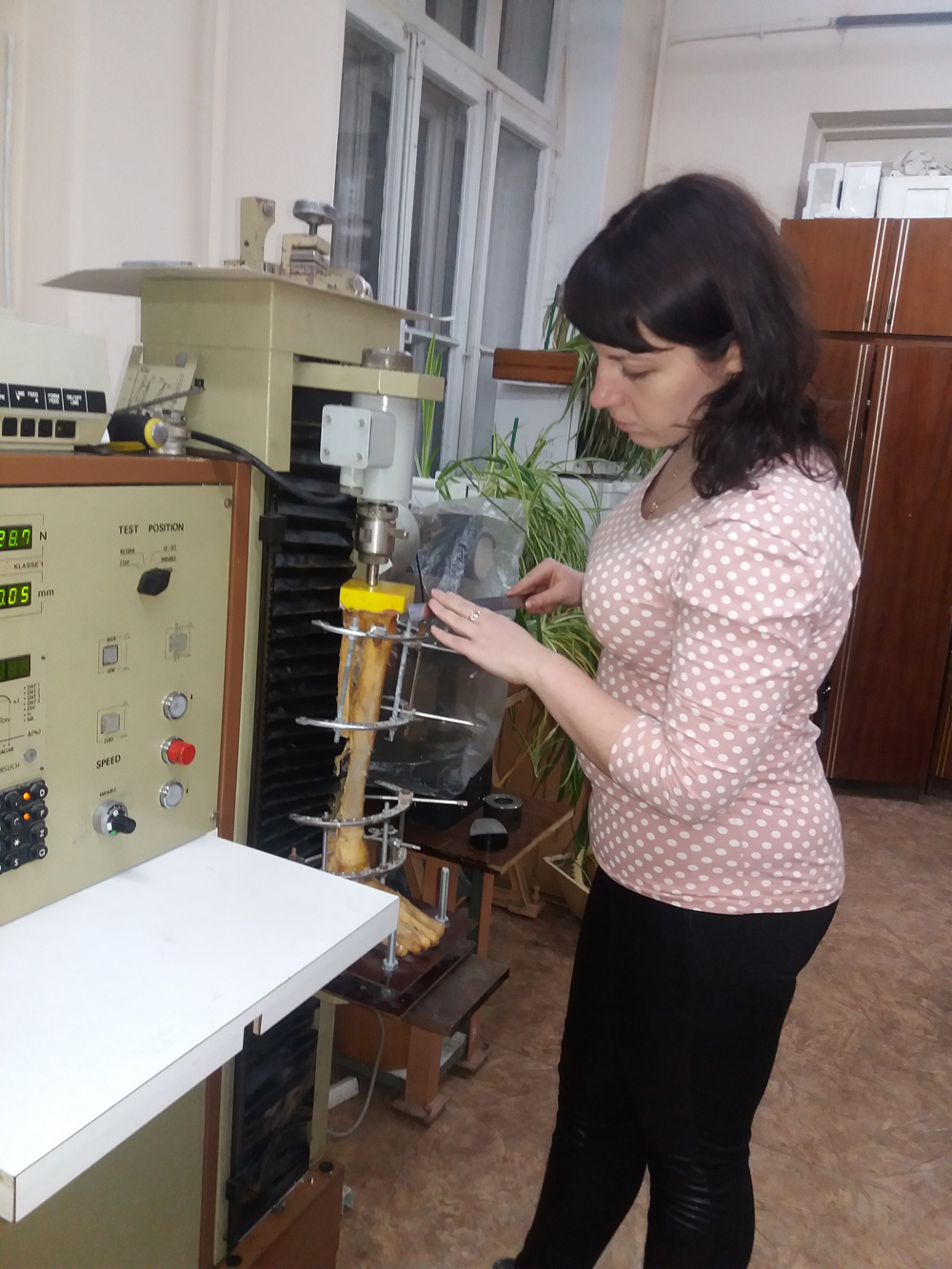
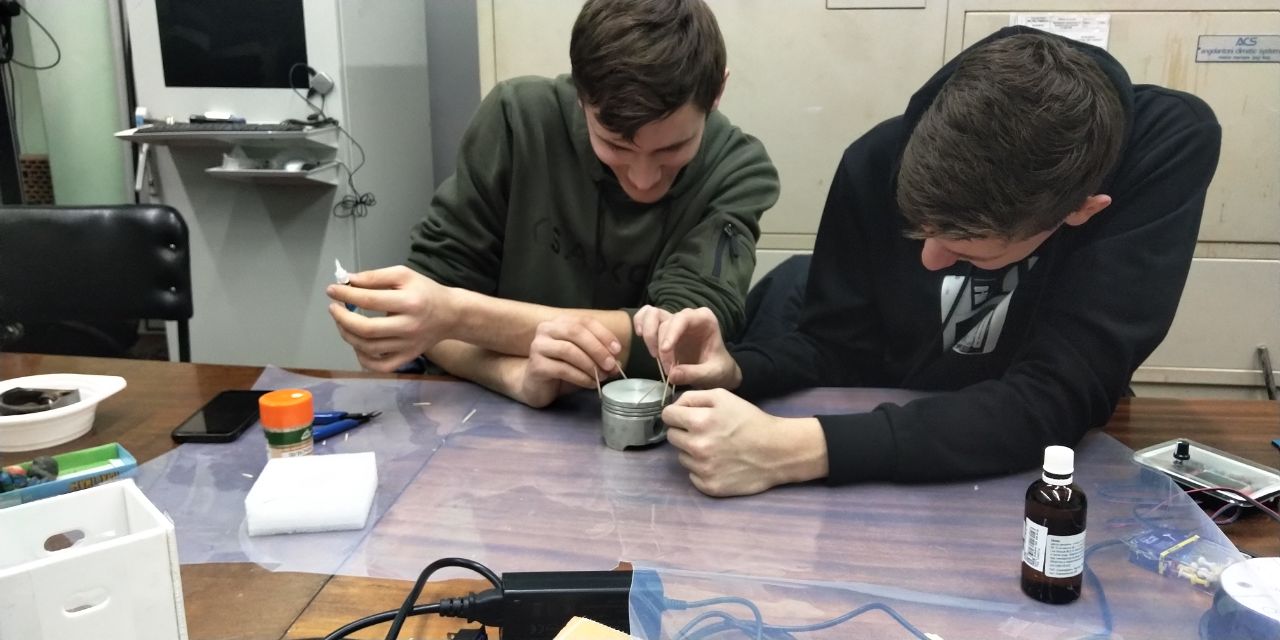
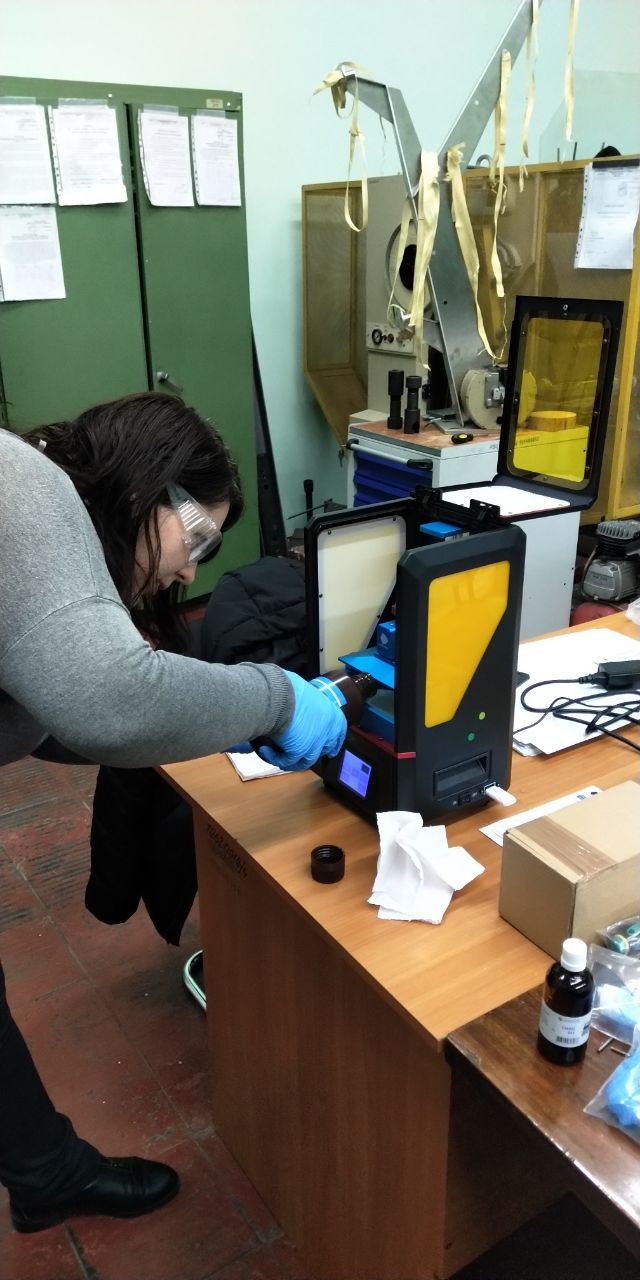
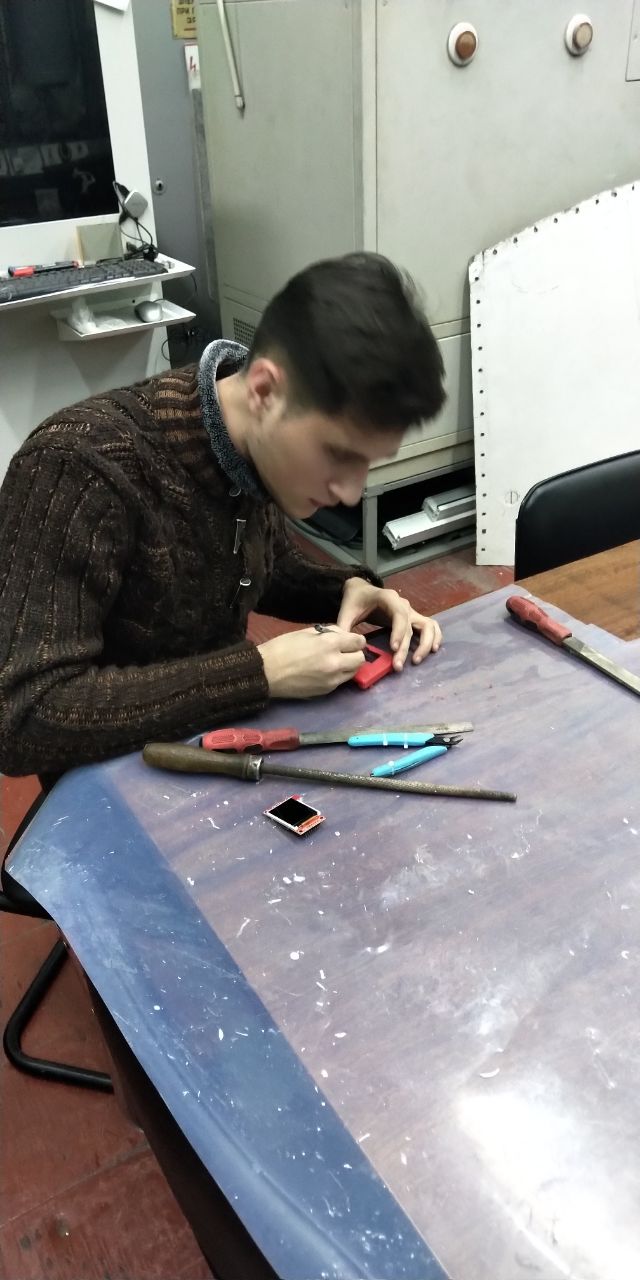
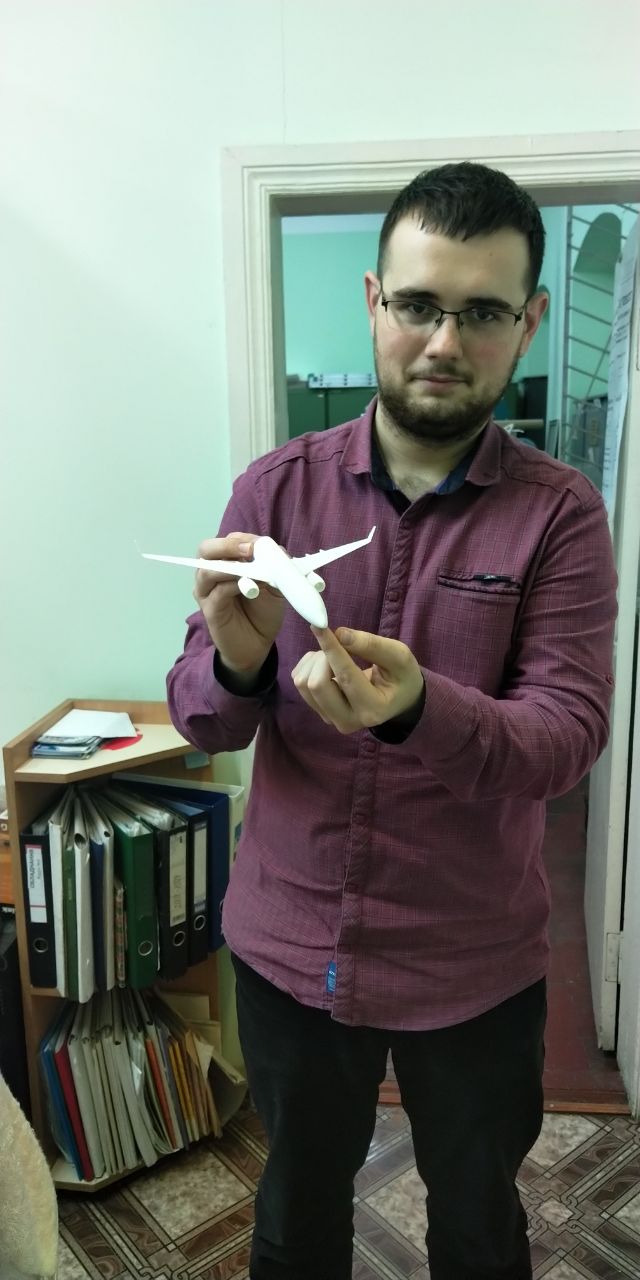

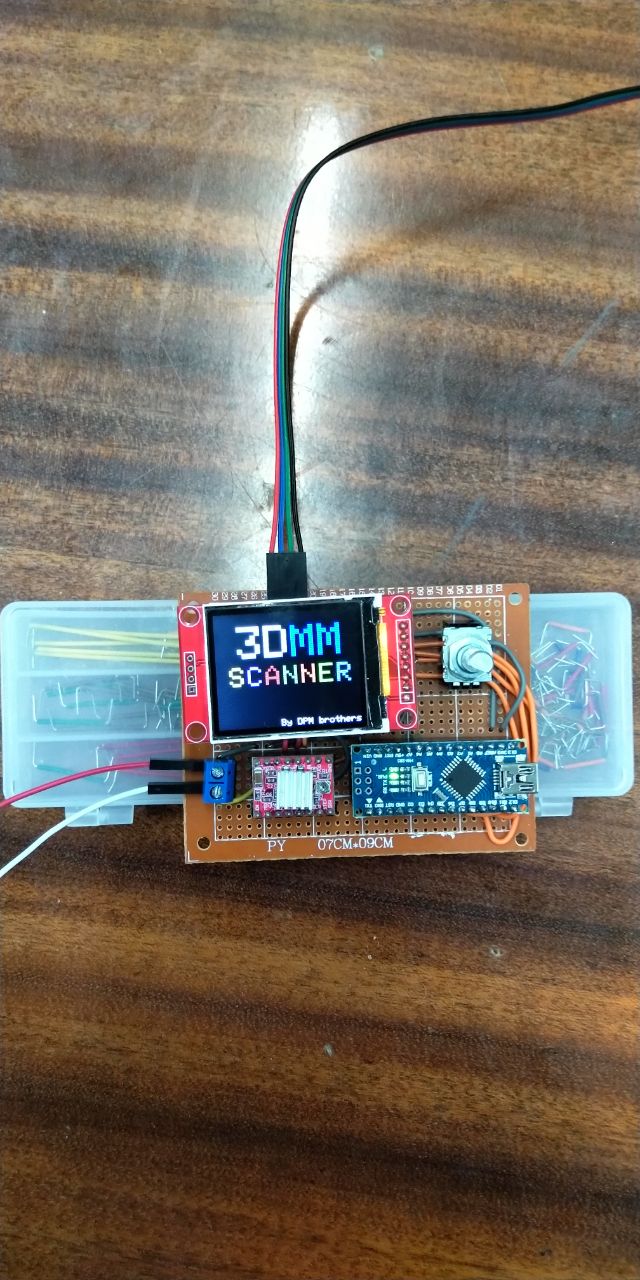
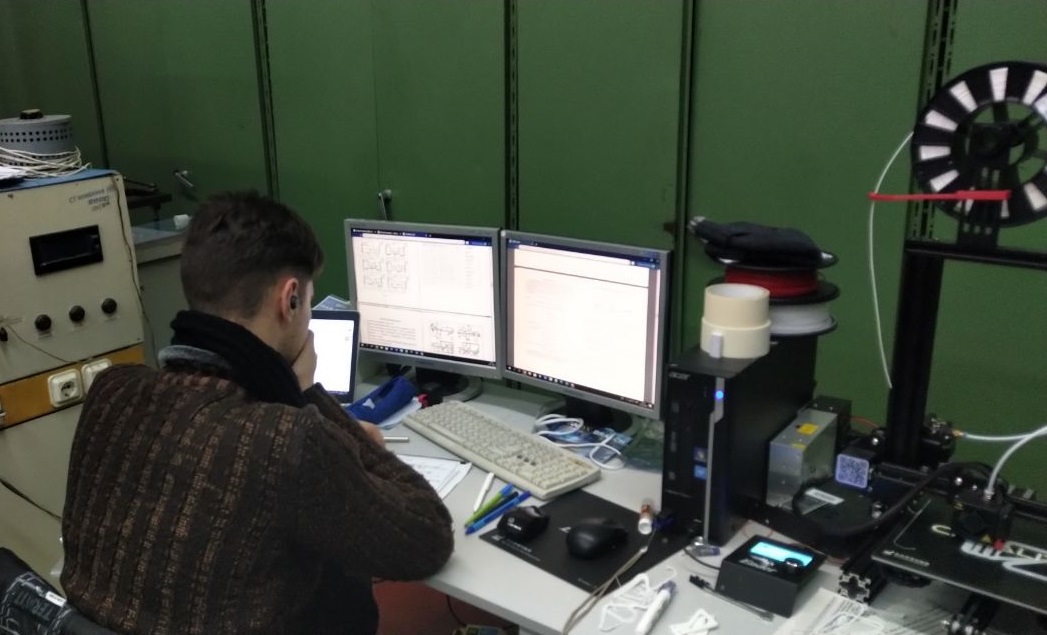
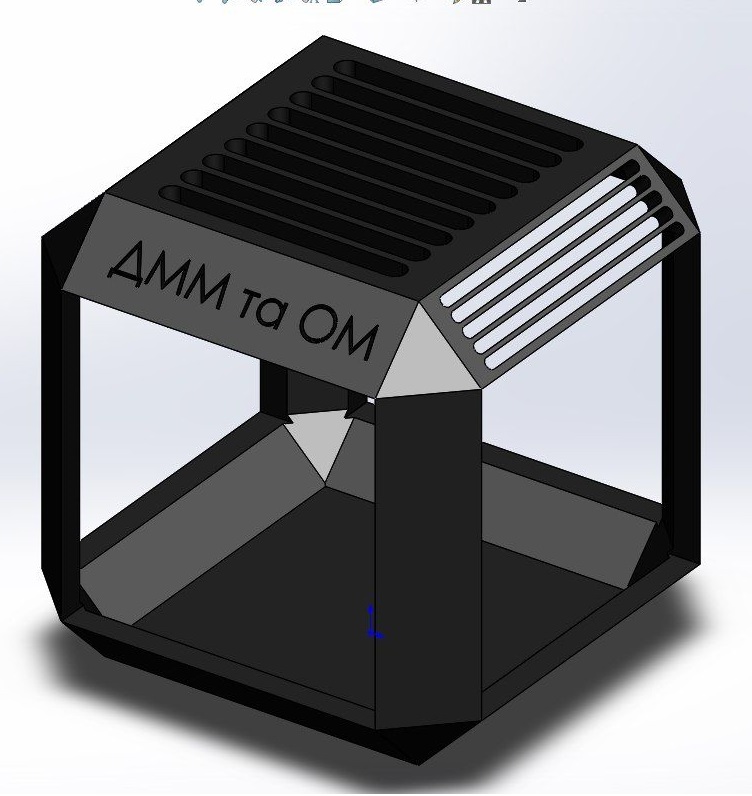
«Прикладні проблеми механіки конструкцій та матеріалів»
Керівник – к.т.н., доцент Заховайко Олександр Опанасович
Викладач - Колодяжний Валерій Ананійович
Тематика роботи
- методи розрахунку конструктивної міцності деталей та вузлів машин
- підготовка до участі в студентських олімпіадах з дисциплін «Механіка матеріалів і конструкцій», «Теорія механизмів і машин»,
- розробка дидактичних матеріалів та програмного забезпечення для навчального процесу з дисциплін «Механіка матеріалів і конструкцій», «Теорія механизмів і машин»
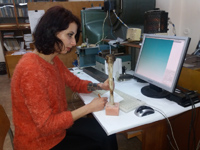
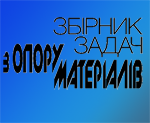 Запропонований збірник містить задачі із основних розділів курсу «Опір матеріалів», передбаченого для машинобудівних спеціальностей вищих навчальних закладів України. До посібника увійшли найактуальніші задачі та приклади, що тісно пов’язані з сучасною та перспективною інженерною практикою конструювання в машинобудівному комплексі. Широко використано матеріал з класичних збірників задач з курсу «Опір матеріалів» за редакцією В. К. Качуріна, А. А. Уманського та інших, а також урахований багаторічний досвід підготовки інженерів усіх спеціальностей у Національному технічному університеті України «Київський політехнічний інститут», зокрема спеціальності «Динаміка та міцність машин». Задачі, що не входять до стандартного курсу «Опір матеріалів» дає можливість прищепити студентам навички дослідницької роботи та передбачає пошук оптимального розв’язання за різними показниками.
Запропонований збірник містить задачі із основних розділів курсу «Опір матеріалів», передбаченого для машинобудівних спеціальностей вищих навчальних закладів України. До посібника увійшли найактуальніші задачі та приклади, що тісно пов’язані з сучасною та перспективною інженерною практикою конструювання в машинобудівному комплексі. Широко використано матеріал з класичних збірників задач з курсу «Опір матеріалів» за редакцією В. К. Качуріна, А. А. Уманського та інших, а також урахований багаторічний досвід підготовки інженерів усіх спеціальностей у Національному технічному університеті України «Київський політехнічний інститут», зокрема спеціальності «Динаміка та міцність машин». Задачі, що не входять до стандартного курсу «Опір матеріалів» дає можливість прищепити студентам навички дослідницької роботи та передбачає пошук оптимального розв’язання за різними показниками.
Збірник сприяє самостійному вивченню теоретичного матеріалу, який викладено переважно в підручниках «Опір матеріалів» за редакцією Г. С. Писаренка та «Сопротивление материалов» за редакцією В. І. Феодосьєва.
До задач, позначених «зірочкою», наведені розв’язки, що полегшує використання посібника під час самостійного навчання.
Збірник задач підготували: С. І. Трубачев (розд. 1, підрозд. 8.2, 5.1, 5.2); Б. І. Ковальчук (розд. 2, підрозд. 8.1); С. М. Шукаєв (розд. 3, 12); О. М. Чемерис (підрозд. 4.1—4.4, розд. 9). А. П. Грабовський (підрозд. 4.5—4.8, 5.4—5.6); В.А. Колодежний (підрозд. 5.2—5.4); О. О. Заховайко (розд. 6, підрозд. 11.7); А. Є. Бабенко (розд. 7, підрозд. 11.8); М. І. Бобир (загальне редагування, розд. 10); О. О. Боронко (підрозд. 11.1—11.6).
 Завантажити Збірник задач з опору матеріалів по розділах
Завантажити Збірник задач з опору матеріалів по розділах
Розділ 1. Геометричні характеристики плоских перерізів
1.1. Площі та центри ваги (pdf 610kb)
1.2. Моменти інерції та моменти опору
Розділ 2. Розтяг і стиск стрижнів
2.1. Статично визначувані системи
2.1.1. Напруження в поперечних перерізах стрижня. Пружні деформації
2.1.2. Розрахунки на міцність і жорсткість
2.2. Статично невизначувані системи
2.3. Температурні й монтажні напруження в статично невизначуваних системах
Розділ 3. Основи теорії напруженого і деформованого стану. Критерії міцності
3.5. Деформації. Узагальнений закон Гука
3.6. Потенціальна енергія деформації
Розділ 4. Зсув і кручення
4.1. Напруження і деформації при зсуві
4.2. Болтові та клепані з’єднання
4.3. З’єднання дерев’яних елементів
4.4. Зварні з’єднання
4.5. Кручення валів круглого поперечного перерізу
4.6. Кручення стрижнів некруглого поперечного перерізу
4.7. Статично невизначувані задачі при крученні
4.8. Гвинтові пружини
Розділ 5. Згин
5.1. Епюри внутрішніх зусиль у поперечних перерізах балок і рам
5.2. Розрахунок статично визначуваних стрижнів і плоских рам
5.3. Деформації та переміщення при згинанні
5.4 Розрахунок статично невизначуваних стрижнів
5.5 Розрахунок статично невизначуваних плоских рам
Розділ 6. Складний опір
6.1. Косий і неплоский згини
6.2. Нецентровий розтяг-стиск. Згин з розтягом або стиском
6.3. Згин з крученням
6.4. Інші види складного опору
Розділ 7. Стійкість пружних систем
7.1. Стійкість стрижнів у межах пружності
7.2. Розрахунок на стійкість за межами пружності
7.3. Наближені методи розрахунку на стійкість
7.4. Поздовжньо-поперечне згинання
7.5. Числові методи в задачах стійкості. Використання ЕОМ
Розділ 8. Бруси великої кривини. Товстостінні циліндри та обертові диски
8.1. Напруження і переміщення в кривих брусах. Розрахунок на міцність
8.2. Товстостінні циліндри та обертові диски
Розділ 9. Пластинки і оболонки
9.1. Тонкостінні посудини
9.2. Згин пластинок і оболонок
9.3. Стійкість пластинок і оболонок
Розділ 10. Розрахунок елементів конструкцій за межами пружності
10.1. Пружнопластичне деформування конструктивних елементів і граничний стан
10.2. Повзучість та релаксація конструктивних елементів
Розділ 11. Задачі динаміки
11.1. Вільні коливання пружних систем з одним ступенем вільності
11.2. Власні коливання з урахуванням сил опору
11.3. Задачі на вимушені коливання пружних систем з одним ступенем вільності
11.4. Вимушені коливання пружних систем з в`язким демпфіруванням
11.5. Коливання систем з кількома ступенями вільності
11.5.1. Вільні коливання систем з кількома ступенями вільності
11.5.2. Задачі на вимушені коливання систем з N ступенями вільності
11.6. Коливання систем з розподіленими параметрами
11.6.1. Задачі на малі вільні коливання струни
11.6.2. Задачі на крутильні коливання валів
11.6.3. Задачі на поздовжні коливання стрижнів
11.6.4. Задачі на поперечні коливання балок
11.7. Сили інерції
11.8. Напруження і деформації під час удару
Розділ 12. Розрахунки на міцність за змінних навантажень
12.1. Основні теоретичні положення
12.2. Визначення параметрів кривої втоми. Характеристики циклу
12.3. Розрахунки на втому за симетричного навантаження
12.4. Розрахунки на втому за несиметричного навантаження
12.5. Розрахунки на втому за складного напруженого стану
Розв’язання та вказівки
Додатки
Література
![]() ПРОГРАМА КОМПЛЕКСНОГО ФАХОВОГО ВИПРОБУВАННЯ
ПРОГРАМА КОМПЛЕКСНОГО ФАХОВОГО ВИПРОБУВАННЯ
для напряму підготовки Прикладна механіка спеціальностей7.05050101, 8.05050101 Динаміка і міцність машин
![]() ДОДАТКОВА ПРОГРАМА КОМПЛЕКСНОГО ФАХОВОГО ВИПРОБУВАННЯ для напряму підготовки Прикладна механікаспеціальностей Динаміка і міцність машин
ДОДАТКОВА ПРОГРАМА КОМПЛЕКСНОГО ФАХОВОГО ВИПРОБУВАННЯ для напряму підготовки Прикладна механікаспеціальностей Динаміка і міцність машин
The mechanics school
The history of development of the department of strength of materials in KPI is concerned with the institute's history and it's founder, the great mechanic and scientist, the organizer of engineering education in our country, the first rector of KPI, prof. Victor Kirpichiow (1845-1913). Right in 1899 he started giving lectures at his department of strength of materials, what built the foundation of training mechanical engineers. Apart from strength of materials prof. Kirpichiow was giving lectures of statics.
He understood that the progress of world's economics and general machinery needs the transportation of mechanics in a new technical period with the main achievements of that time.
In 1896 prof. Kirpichiow, speaking at the Second Congress of the Russian figures of technical and professional education with the report titled "Experimental Mechanics and Mechanical Laboratories in higher special schools" first substantiated the need to introduce in higher education for mechanical specialties systematic teaching of experimental methods for the study of materials and machines, and at least a two-year study of special methods of experimental mechanics specialized in mechanical laboratories. He brought to life his ideas in Kiev Polytechnical Institute.

In autumn of 1900, after the end of construction of the main building of the institute, prof. Kirpichiow began organizing the mechanical laboratory. The laboratory was equipped with a 100-ton machine "Ryl" 60-ton press Amslera, bursting 5-ton machine and a machine for testing in torsion of the same company. This experimental base has created quite a good entry points for the main types of mechanical testing of materials.
There were the first laboratory training in the spring of 1901 in testing of metallic materials, wood and cement. In september 1902 prof. Kirpichiow resigned, however, as an elected member of the Institute he was steal giving lectures of strength of materials to students of mechanical, chemical, engineering department and professional course of construction mechanics (calculation of statically indeterminate systems) for engineering department. According to the statements of Tymoshenko prof. Kirpichev was an excellent lecturer. The shape of his lectures was very simple, without any oratorical activities, logic and clear in presentation. In the spring of 1901 were the first laboratory training in testing of metallic materials, wood and cement. While VL Kirpichev in September 1902, due to deteriorating health, resigned, however, elected an honorary member of the Institute, the Institute remains complete teaching course on strength of materials to students of mechanical, chemical, engineering offices and professional course of construction mechanics (calculation of statically indeterminate systems) for engineering department. According to the statements of SP Tymoshenko VL Kirpichev was an excellent lecturer. The shape of his lectures were very simple without any oratorical activities and different logic and clarity of presentation. Freed from administrative matters, prof. Kirpichew wrote one of the greatest of his works "Зайва невідома в будівельній механіці" (published in 1903).
Professor VL Kirpichev was one of the first in Russia who issued the most comprehensive course on strength of materials and static structures. He was the first in the country conducted experiments to study the stressed condition in structural elements using polarization-optical method, for which he designed a simple but original special optical setting. In 1903 prof. Kyrpychov was elected ar a member of a building committee of the St. Petersburg Polytechnic Institute, he began to give lectures of structural mechanics. After moving to St. Petersburg he continued being interested in the affairs of the Kiev Polytechnic Institute, where during 1904-1906 the Department of Strength of Materials was headed by Professor V. Serebrovsky. A wide step in the development of the solid body in the KPI were years of management of the department of Strength of Materials (1906-1908) by Professor S.P. Timoshenko (1878-1972), who later became a world-renowned engineer-scientist , academician of many academies, including the USSR and the Soviet Union. Totally prof. Tymoshenko worked at the Department of strength of materials as a professor from 1906 to 1920 with a break (1911-1917). During this period the laboratory at the department of mechanical strength of materials enriched with a number of new testing machines and systems. Along with lectures prof. S.P.Tymoshenko wrote a course of support materials, which was published in 1911. The course was a great success and was published as a textbook, later reprinted many times in our country and in many languages (11 editions). This tutorial, which has not lost its significance now, played a major role in the formation of mechanical engineers and scientists who are solving complex problems of strength and bearing capacity of machines and structures around the world. At the same time S.P.Tymoshenko performed great organizational work, being elected as a dean of faculty of mechanical engineering in the KPI (1909-1911). In 1918, he took an active part in the work of Vernadsky Commission to develop a project on the establishment of the Ukrainian Academy of Sciences. Prof. Tymoshenko became a one of the first members of the Ukrainian Academy of Sciences in 1919. In 1919-1920 he was the founder and first director of the Institute of Engineering Mechanics (now the Tymoshenko's Institute of Mechanics. ) National Academy of Sciences of Ukraine.
Since 1911 to 1913 the KPI's department of strength of materials was headed by Professor M.A. Voropajev, who was the first in the world practice who conducted various studies of fatigue iron. The results of these studies, which were ahead of similar work abroad have not lost it's scientific significance today. An important step in the development of research strength in the KPI, as well as in the preparation of engineering and scientific specialists of the solid body, was a period of department of strength of materials management (1914 to 1932), professor, academician of the USSR (1926) K.K. Syminsky (1879-1932), who in addition to improving the rate of resistance of materials brought the study of course of static structures to the higher level .
Prof. K.K. Syminskyy paid much attention to the development of the laboratory of strength of materials in the direction of control materials testing, various machine parts and engineering constructions for the industry. Mechanical Laboratory of Strength of Materials of the Department was the central station for testing materials in Ukraine and some other Soviet republics. Thus, the department of strength of materials of KPI headed by prof. K.K. Syminskoho was involved in the reconstruction of industry and transport, destroyed by imperialist and civil wars.
.
There were significant works about selecting allowable stress for welding iron bridges conducted by the department of strength of materials in the mid 20-ies under responsibility of K.K. Syminskoho, by selecting . In addition to teaching and researches K.K. Syminskyy did a great organizational work. Taking positions of Dean of the Faculty of Civil Engineering in 1920-1921, vice-rector for academic work of KPI in 1924-1926 and a member of the State Committee for Scientific and Methodological in USSR, he was actively involved in the reorganization of Higher Education. .
In addition to lectures and practical sessions with students and providing practical assistance to industry the department staff of strength of materials conducted a great research work. Under the guidance of prof. Syminski were conducted complex research projects, including a research work of S.V. Sorensen "О напряжениях при изгибе анизотропних балок (как плоская задача теории упругости)". It was reported in 1930..
The Department of Strength of Materials gave to S.V. Serensen, a student of mechanical department of KPI (graduate 1926), a ticket to the big scientific life. He passed all stages: from the laboratory to the Professor, Head of Department (1931.). From 1932 to 1940 S.V. Serensen was director of Institute of Structural Mechanics of USSR Academy of Sciences and a head of the Department of aircraft in Kiev Aviation Institute (1933-1941). In 1939 he was elected as an Academician of the USSR. S.V.Serensen is the world famous founder of scientific direction of cyclic and thermocyclic strength of modern engineering. including Aviation Motors, destruction and durability of engineering structures.
After the death of K.K. Syminski the strength of materials department was headed by prof. P.V. Rabtsevych who ran it until early 1941.
During this period were continued studies of strength of wooden structures, stone and granite rocks of Ukraine in the laboratory of strength of materials, which was started by K.K. Syminski who greatly expanded the work to assist industry and field testing of materials, parts and engineering structures. In the prewar years KPI conducted researches of strength in energy engineering, the results of which were defended as theses of graduate A.D.Kovalenko " Research of voltage at the wheels turbomachinery" (1938), members of the department M.I. Chernyak "The impact on the rate of deformation characteristics of the stress state" (1938), K.I. Kolenchuko "The maximum bending rods real constant and variable cross-sections" (1938) and graduate G.S. Pisarenko "Determination of deflections and stresses in steam turbines detachable elements" (February 1941).
Because of the occupation of Kyiv by Germans, many teachers of the department were evacuated from Ukrainian Science Academy to Ufa and the Laboratory of Strength of Materials in KPI in Kiev almost ceased to exist. During the War the department's building was destroyed and a lot of the equipment removed. The department resumed its activities in liberated Kiev in 1944. The Department of Strength of Materials was headed by corresponding member F.P.Belyankin USSR Academy of Sciences (Academy of Sciences of the USSR since 1948.). Along with the leadership of the department (1944-1952 years), he was director of the Institute of Mechanics, USSR Academy of Sciences (1944-1958 years), read lectures "Strength of Materials" and "Theory of elasticity."
From the earliest days in the postwar period of the department took an active scientific work. As a result at the end of 1945 A.D. Kovalenko doctorate "Tension and bend symmetric and asymmetric disk profiles." In that same year there was defended a thesis of M.M. Afanasyev "Statistical theory of strength." In 1948 doctoral thesis was defended by G.S. Pisarenko on "Forced oscillations of elastic systems based on energy dissipation in the material" and his thesis E.S. Umansky "Calculation drive with asymmetric load of blades", performed under the supervision of A.D. Kovalenko. In 1949 were defended a thesis of B.I.. Oks "Using optical method for calculating frame structures", performed under the direction of F.P. Byelyankin.
In 1952 the leading of department was given to prof. H.S.Pysarenko (1952-1959 and 1961-1984), who greatly expanded the research work of the Department of topical issues related to the theory of vibrations of elastic systems taking into account the energy dissipation material strength of a wide range of construction materials and structural components at high temperatures, which are of great scientific and practical interest in connection with the development of new technology. Prof. Khilchevsky was a dean of the Department of strength of materials in KPI from 1959 to 1961. As he began leading the department prof. Pisarenko made his own task to do everything he could, in order to develop the department relying the old traditions and new technology. The Department of Strength of Materials had a great experience of education, science, organization and research at the time. Scientists, who have worked in the past at the department, left their mark in the development of solid deformable body mechanics and engineers, mechanics training gave glory to KPI . In addition to the first head of the Department of strength of materials and first director of the KPI we should mention Professor V.L.Kyrpichova, there may be mentioned academics: S.P.Tymoshenka, K.K.Siminskoho, Paton, O.M.Dynnyka, M. M.Davydenkova, F.P.Belyankina, S.V.Serensena, A.D.Kovalenka and others.
The following issues systematically and consistently solved Pysarenko:
- Attraction the talented youth for work at the department ;
- Strengthening a collaboration with researching institutes of the Academy of Sciences of Ukraine;
- Attraction the leading scientists of the Academy of Sciences of Ukraine to work part-time at the Department;
- The organization of academic training through graduate school using experimental basis not only students, but also the Academy of Sciences;
- The organization of scientific seminars Department involving scientists of other universities and Academy of Sciences of Ukraine;
- Improving the teaching of the strength of materials and other items that were tought in all directions mechanics of solid deformable body;
- Establishing text books on strength of materials and other teaching aids, especially from laboratory studies as a prerequisite for raising the level of assimilation lectures and other teaching students;
- Particularly important for him was a friendly staff, departments like-minded artists, who love their work and who are willing to help each other for in circumstances.
It should be noted that the main tasks in the work of each department are still relevant today. H.S.Pysarenko trained highly qualified scientific staff from a number of talented young people. H.S.Pysarenko was head of the Department Strength of Materials for 32 years, most of them (26) were part-time, working on substantive work in the Academy of Sciences, director of the Institute for Problems of Strength of Sciences of Ukraine (1966-1988), The main Scientific Secretary of the Presidium (1962-1966) and the first vice president of the Academy of Sciences of Ukraine (1970-1978). Of the total number of 175 candidates he trained in the Department of Strength of Materials in KPI successfully graduated from the university 69 people.
The creative collaboration with academic departments contributed the development of research and successful preparation of the scientific staff at the department and metal fussions Institute of USSR Academy of Sciences, the institute of durability USSR Academy of Sciences since 1966 , which was led by H.S.Pysarenko. Thanks to this creative connection in 1952 and leadership of H.S.Pysarenko has developed the academic training for strength.
To characterize the scientific orientation made in this period of work of Kyiv School of professionals of strength of materials and structures, we present a list of doctoral dissertations, which are made at the department since 1952 : "Міцність і в'язко-пружні властивості м'яких армованих пластиків (E.C. Umansky, 1964). "Вплив напруженого стану та характер напружень на розсіяння енергії в циклічно деформованому матеріалі" (V.V. Khilchevsky, 1969), "Закономірності деформування та критерії витривалості жароміцних матеріалів за термоциклічних навантажень" (M.S. Mozharovskyi, 1969), "Нелінійно-гістерезисна задана механіки деформованого тіла" (M.V. Vasilenko, 1973), "Критерії граничного стану матеріалів за умов програмного малоциклового навантаження" (E.O. Antipov , 1984), "Узагальнені методи і розв'язки технологічних задач механіки нелінійно-деформованих електропровідних тіл" (O.S. Tsybenko, 1986), "Критерії граничного стану конструкційних матеріалів при складному малоцикловому навантаженні" (M.I. Bobyr, 1991), "Ефективні алгоритми розв'язання тривимірних крайових задач механіки деформівного твердого тіла методом скінчених елементів" (K.M. Rudakov, 1996), "Критерії граничного стану металевих сплавів при двовісному малоцикловому навантаженні" (S.M. Shukayev, 1996), "Використання і розвиток методу покоординатного спуску в задачах визначення напружено-деформованого стану при статичних та вібраційних навантаженнях" (A.E. Babenko, 1996.).
редактировать
This is only a master's thesis completed under the supervision H.S.Pysarenka directly to the Department of Strength of Materials KPI under his management from 1952 to 1984 .. Results from 1952 to date under his leadership in the CPI and the Academy of Sciences has trained about 175 candidates and 36 doctors. Interesting work at the Department of Strength of Materials was led by prof. ES Uman strength of soft plastic. The results of these studies have been Thesis: GV Bilidy (1972), LL Footpath (1990), MS Shydlovsky (1983). In recent years, further development at the Department of acquired actual strength heat-resistant materials research carried out under the guidance of prof. MS Mozharovsky, which in 1984 was transferred to the Department leaders. The results of these studies were the basis of theses: MI Bobyr (1981), OP Zahovayka (1982), KM Rudakov (1984), SM Shukayeva (1987) I.0. Bilyk (1987), OB Ovsienka (1990), AN Mucoids (1990), and TB Ponomarenko (1994). It should be noted the great contribution of talented graduate 1989. Departments DSM and OM. Timothy B. Ponomarenko to support over 1990? 2003r.r. actual research department staff to address problems and damage of predicting the residual life of structural elements responsible gas transport systems in Ukraine and Russia termosylovyh operational activities. Under the direction of Professor M. Vasilenko are protected dissertation: O. Chirkova, (1987), ID Kamenychnoho (1990), AA Harrows (1990), SL Boyko (1990) and SI Trubachev (1993), AM Pavlovsky (1993).
This list of topics dissertation work performed mainly graduate students in active resistance of materials using laboratory facilities academic institutions indicates a wide range of scientific subjects in mechanics of deformable bodies covering all major aspects of the science of strength of materials. The following subjects performed at the Department of theses, is a clear illustration of the dynamics of the aforementioned research directions. These results define the country's technological progress in many areas of engineering, particularly in the areas of new technology. Feature of the school, which developed from inception strength of materials department KPI is a close connection with life, the desire to solve urgent tasks specific to practice. Thus all theses sections were always thematic plan of scientific work of subordinate address the pressing problems of engineering complex of the USSR. This can be important to confirm the results of research conducted at the department during the last century, according to the needs of countries at different stages of development, from vidbudovchyh period after the imperialist and civil wars until the present day. So after re-evacuation Polytechnic Institute in 1944 from Tashkent to Kyiv, when it went on the Great Patriotic War, the work of the Department of Strength of Materials Laboratory began to restore the building, which during the war was finally destroyed. Many test equipment was removed, especially gauges. Warehouse employees of the department headed by Corresponding Member. USSR Academy of Sciences FP Byelyankinym at that time was minimal. In the fall of 1944 in unheated rooms institute has been restored war interrupted the learning process.
After the restoration laboratories and obtain some additional equipment, the Department continued to work with different kinds of tests of structural materials for businesses and organizations involved in reconstruction of destroyed buildings, railway bridges, and so on. In this period began to develop research to address major problems of strength, which put forward new art, such as gas turbine, nuclear power, missiles and aviation equipment and so on. According to the needs of these areas of technology and research developed to address the urgent problems of strength during the next period to the present day. Of particular importance for the past 40 years, the department acquired resistance of materials research in the study of the strength of materials and structural elements under extreme conditions termosylovoho load on the real state of vysokonapruzhenyh structural elements of new technology. Extreme conditions is as follows: high temperatures (up to 3000 ° C and above), low temperatures (up to 4,2 ° C) teplozminy sharp, aggressive environment, irradiation, resonant modes of mechanical vibrations, high frequency application variable loads, shock load, prolonged action loads at high temperatures and complex stress state, and so on.
In the operation of many bearing elements of machines and devices that form the basis of power machines, aerospace vehicles, transport engineering and others. working in a complex termosylovoho load. Therefore, the rationale for selection of structural materials, shapes and sizes definition of a detail, ability to resist, not destroyed, the actions of power and thermal effects, given the environment, temperature and time factors, providing a predetermined lifetime, there is an important task that is put before engineers -konstruktoramy in the present conditions of technological progress. In addressing these issues many strength affecting major consideration termosylovyh factors that accompany the actual conditions of operation of the new technology, were subject during the last decades of research that they conducted post-graduate students and staff strength of materials KPI.
It should be borne in mind that the successful implementation of many studies of the main problems of solid mechanics of deformable bodies graduate students largely determined cooperation of the Department of institutes of Academy of Sciences of Ukraine, including the Institute for Problems of Strength. Such organic connection (enabling the use of laboratory facilities and support services Academy of Sciences to address contemporary issues strength topical subjects) gave the highest quality, scientific results.
Many studies that have been implemented in such a creative collaboration, reflected in several monographs summarizing. In particular it should be noted here monograph "The strength of the material at high temperatures," which was published in 1966, edited by Head. Department Academician of USSR GS Pisarenko, which in 1969 was reprinted in English in the United States. For this group of authors monograph in 1969 was awarded the State Prize of the USSR. The second double volume monograph summarizing group of authors of the Institute for Problems of Strength USSR Academy of Sciences and the Department OM "The strength of materials and structural elements under extreme conditions," published in 1980, edited by H. Pisarenko. This monograph, which is unique in world literature, in 1982 awarded the State Prize of the USSR. Among other books published by the department, reflecting the focus of school operators that solve actual problems of strength and bearing capacity of structural elements in the CPI, should include:
GS Pisarenko, "Oscillations of elastic systems based on energy dissipation in the material";
GS Pisarenko, "energy dissipation by mechanical vibrations";
GS Pisarenko, "Strength of deformation and fracture of materials for complex stress state";
GS Pisarenko, "Vibrations of mechanical systems based on imperfect elasticity of the material";
GS Pisarenko, AP Yakovlev, VV Matveev "Vibropohlynalni properties of construction materials" (directory);
GS Pisarenko, MS Mozharovskyi, EO Antipov "resistance high-temperature materials and transient thermal effects" (in 1983 the book was awarded the prize of 1 degree KPI).
GS Pisarenko, A. Lebedev "Deformation and strength of materials for complex stress state";
GS Pisarenko, MS Mozharovskyi "equation and boundary value problems of the theory of plasticity and creep."
For basic research problems vibrations of mechanical systems based on hysteresis in the material in nonlinear formulation, which was summarized in monographs: "Fluctuations of elastic systems based on energy dissipation in the material" (1955), "The scattering of energy in mechanical vibrations" (1962 ), USSR Academy of Sciences academician GS Pisarenko noted in 1968. Prize of the Academy of Sciences them. NM Krylov. Research vibrations of mechanical systems, including gas turbine blades based on energy dissipation, developed GS Pisarenko and his many pupils gained worldwide recognition.
Of particular note is the great work of the department KPI strength of materials for writing textbooks and reference books for the course support materials. So by the department GS Pisarenko, VA Aharyevym, AL Flower, VG Popkov and ES Umansky. was written several books, including a complete course for mechanical specialties. This textbook first published in 1963 titled "Strength of Materials", which has been a Ministry of Education of Ukraine as a textbook for students of mechanical engineering and universities. He then reprinted in 1967, 1973, 1979 and 1986. The last three editions has been USSR Ministry of Education as a textbook for students of engineering education in the former Soviet Union. This tutorial in 1973 was awarded the first prize KPI.
The above named group of authors in 1964 published in the Academy of Sciences published a short tutorial on strength of materials called "Course strength of materials." Then, edited by H. Pisarenko published "High School" in 1967 were published and republished in 1974 textbook on strength of materials called "Strength of Materials". Both works also has been a Ministry of Education of Ukraine as a textbook for students of technical universities. Prof. MS Mozharovskyi issued a series of textbooks on the theory of plasticity and creep. These include: "The theory of plasticity and polzuchesty" in engineering Actually "(1991).," Methods and algorithms solutions kraevыh problems "(1991. In collaboration with N.Ye.Kachalovskoyu) and" theory of elasticity, plasticity, and creep '(2002).
GS Pisarenko, AP Yakovlev and V. Matveev prepared "Handbook of Strength of Materials", which was published in 1975. Publishers' scientific opinion "and twice (in 1979 and 1985 years) reprinted by the publisher" Mir ". In those authors were created directory "vibration properties of structural materials", which was published in 1971 in Kiev, Russian and reissued Polish, French, Spanish and Portuguese. In 1993 the authors GS Pisarenko, AL Flower and E.S.Umanskym published a new book "Strength of Materials" in Ukrainian. This is the fourth edition of the resistance of the material that has been published for more than a half-century as labor GS Pisarenko KPI.
The publication of monographs department staff, as well as educational and reference materials for durability, contributed to the development of the school mechanics Kiev Polytechnic Institute, which is recognized not only in our country but also abroad. This, in particular, suggest translations number of employees at the Department of English, Polish, French, Spanish, Portuguese, Romanian and Czech language. In order to prepare highly qualified mechanical engineers and researchers an important step in the development of the school "mechanics" KPI is the organization in 1970 at the Department of Strength of Materials specialty "Dynamics and Strength of Machines". The need for such specialty was caused as the needs of academic institutions such as the Institute for Problems of Strength, Institute of Mechanics, Institute for Superhard Materials, Institute for Materials Science, Institute of Electric. EO Paton and major engineering, aircraft construction and shipbuilding companies. In particular such as Kyiv Mechanical Plant, Kyiv Aviation Industrial Association, NGO "Bolshevik" (m. Kyiv). Zaporozhye Engine Plant, CB "Progress" (Kiev) and others. Complications to date design problems at the design stage of new technology products led to the urgent need to solve problems of strength. Addressing these challenges requires the use of special complex mathematical apparatus and the ability to put experimental study on the strength of machine parts and structural elements operating in extreme conditions. Therefore, the basis for the preparation of such professionals have a deep mathematical training at the Mechanics and Mathematics traditional universities, but the applied bias. Graduates called specialty should be able to prove the results of mathematical calculations to engineering applications rozroblyuvaty corresponding mathematical models and have modern computing systems. At the same time, they need to have in-depth professional training in experimental studies. Main courses which provide the required level of training is analytic geometry and linear algebra, mathematical analysis and exchange of mathematical physics, mathematical statistics course and probability theory.
The issue of professional training courses provided theoretical mechanics, analytical mechanics, strength of materials, theory of elasticity, structural mechanics machines, theory of plasticity and creep resistance and vibration theory, methods of solving problems of mechanics on a PC. Teaching these and other courses provided by highly qualified experts: prof. Babenko AE, prof. M.I.Bobyrem Sci. MV Vasilenko, prof. AS Tsybenko Sci. KM Rudakov, Assoc. OM Chemerys, prof. S.M.Shukayevym Sci. BI Kovalchuk, Assoc. AP Zahovaykom Assoc. M.S.Shydlovskym and others. Engineering students provide training courses such as Engineering basics, dynamics and design of machines, the theory of strength of materials under repeated variable loads, experimental methods in mechanics of solid deformable body. Since the training of students up to date on the basis of material only faculty or, worse, a department is not possible, the training of specialists was scheduled to conduct involving not only the leading scientists of the Institute of Problems of Strength of. H.S.Pysarenka NAS of Ukraine (IPM), but its material base. To this end, part of the course, mainly at the undergraduate, conducted in the laboratories IPM. In addition, students in the practical work involved in the execution of real scientific research in academic institutions NAS of Ukraine. In today called specialty trained about 900 professionals, including 11 graduates defended doctoral (SE Umansky, V. Weinstock, A. Boyko, press brake YB, Kosarchuk VV, Kharchenko In .In., Orynyak IV, Rudakov KM, SM Shukayev, Merzliakov VA, Majboroda VS), more than 100 graduates defended their dissertations. The formation of the Institute for Problems of Strength USSR (1966) was preceded by extensive work with Head of the strength of materials CPI, founder and first director of IPM, academician of the USSR Academy of Sciences GS Pisarenko to prepare candidates through graduate school. It was his ties with the CPI (since 1937) and the Department of strength of materials made it possible to adopt a postgraduate talented youth from which quickly grew world-renowned scientists who are now not only at the Department of Strength of Materials "KPI" but in IPM and in many universities of the former Soviet Union and abroad. These scientists and engineers who have completed the CPI, or graduate school at KPI and gained worldwide recognition include: NAS of Ukraine (now director of the Institute for Problems of Strength of. H.S.Pysarenka, NAS Ukraine VT Troscheno, NV . Novikov (Director of the Institute of superhard materials im.V.M.Bakulya NAS Ukraine) and AA Lebedev, a member of the NAS of Ukraine VV Matveev and Krasovskii AY, professors M. Vasilenko GV Isahanov, MS Mozharovskyi, GM Tretyachenko, VV Khilchevsky, SH.U. Galiev, GV Stepanov, VA Stryzhalo, cap VI, E .S. Umansky, doctors, V.O.Borysenko, Lyashenko BA, AP Yakovlev, L. Kravchuk, VV Pokrovsky, GA Gogotsi, AL flower, VA Gryaznov, VV Kryvynyuk and others.
Big importance for the further development of the school mechanics are Republican Interuniversity seminars on strength of materials and structural mechanics that they systematically conduct (since 1962) Department of dynamics and strength machines and strength of materials "KPI".
Significant impact on the development of the Kyiv School of Mechanical that address different scientific problems of strength of materials, in recent years had Union monthly magazine "Problems of strength", launched on July 1969 at the Institute for Problems of Strength USSR.
Strengthening the position of the Kyiv School of Mechanical contributed as scientific seminars and conferences on various aspects of durability, held in conjunction with the Department of IPM them. H.S.Pysarenka. In particular, Scientific and technical meeting on energy dissipation during vibration, held in conjunction with the Department of IPM them. H.S.Pysarenka (since 1956 every two or three years), acquired a value that went beyond our country. Named seminars secured Kyiv School of Mechanics global priority in vibromitsnosti.
Note that at the Department of DSM and OM "KPI" grew and worked great galaxy of scientists - engineers, each with their original research has left its mark in the relevant field of solid mechanics of deformable bodies, and their achievements were marked by the scientific community. evidenced in particular election many of them members of Academies of Sciences. These scientists are academician of the Soviet Union, Ukraine and Russia Academy of Sciences, who worked previously. OM Dynnyk, SP Tymoshenko, Ukraine academician FP Byelyankin, MN Davidenkov, AD Kovalenko, MV Kornoukhov, A.O.Lebedyev, EO Paton. SV Sørensen, KK Syminskyy, GP Suhomel, VT Troshchenko, NV Novikov. Member of the Academy of Sciences of Ukraine: VN Gorbunov, IJ Shtayerman, V.V.Matveyev, A.Ya.Krasovskyy, professors VL Kirpichev, MA Nikolaev, V. Fur, NA Zhudyn, OA Uman, PV Rabtsevych, MN Afanasyev, MI Chernyak, V. Khilchevsky, ES Uman, VA Stryzhalo, SH.U. Galiev, GM Tretyachenko, AL Flower, VM Kyselevskyy, M.S.Mozharovskyy, Ye.O.Antypov and others.
 In 1989 chairman of the department of dynamics and strength machines and strength of materials was chosen Ph.D. prof. EO Antipov. Throughout his time in office chair continued scientific work in its traditional academic areas.
In 1989 chairman of the department of dynamics and strength machines and strength of materials was chosen Ph.D. prof. EO Antipov. Throughout his time in office chair continued scientific work in its traditional academic areas.
In 1994 chairman of the department of dynamics and strength machines and strength of materials was elected prof. MI Bobyr. He, despite the difficult socio-economic conditions could support the traditional atmosphere of the department focus on new scientific achievements. An indication of this are reserved in 1996 at the Department 3 and 1 doctoral candidate's dissertation. A modern scientific research laboratory of computation, which facilitates the learning process to date. Launched new areas of scientific research department, enabling a modern complex environment to maintain the high scientific potential that has been accumulated by his predecessors. So at the Department renewed certification testing a wide range of construction materials and structural elements of new technology products in accredited national standards of Ukraine: Research Center "Reliability" (supervisor prof. Bobyr MI) and the research laboratory of polymer and composite materials (head Assoc. Shidlovskii MS). This made it possible to update the material and technical base of the chair and attract students to perform real scientific research. In addition, scientists of the department, such as professors; Ph.D. Babenko AE, Stybenko OS, Kovalchuk BI etc .; Associate Professor: Ph.D. Grabowski AP Kryschuk MG, Zahovayko AP, AA harrows, Trubachev SI Shidlovskii MS and others. always perform hozdogovornye work with industry such as IBC "Southern" ASTC "Antonov" Ukrtransgaz and others. Now the department has: A. NAS of Ukraine Lebedev, professors, MI Bobyr, NV Vasilenko, A.Ye.Babenko, B. Kovalchuk, AS Stybenko, VA Stryzhalo, K.M.Rudakov, S.M.Shukayev, V.V.Harchenko, F.F.Hihinyak, Associate Professor: A.P.Hrabovskyy., Harrows OO Vizerska GE, Zahovayko A. P. EE Onishchenko, Peter V., Goncharenko AI, Pistelkors IS, AN Protaschuk, Rogozin LV, Mozharovskyi VM Slyepyshev IV , Trubachev SI Kolodyazhni VA Shpak DY, Shidlovskii MS, Chemeris OM Sydorko AA Sidorenko YM, Kryschuk MG, Lamashevskyy VP and assistants: Smith VP, Timoshenko AV, Babiyenko II Note two specialist engineers who have devoted their creative work of the laboratory facilities of the department. This mechanic Michael S. Ruzhytskyy who worked at the department from 1898 to 1956, and his son, Associate Professor Boris Ruzhytskyy who worked at the department from 1931 to 1985 Talent remarkable dynasty Ruzhytskyh have much mechanical installations, appliances and devices that are decades scientists of the Department during the research work and studies.
Today, the Department of resistance of materials was from 1970 the department, which began training engineers and mechanics researchers with the strength and dynamics of machines, has become the leading department with the strength and reliability of machines and structures, while providing general engineering courses teaching support materials to students of many faculties "KPI".
At the department, in addition to mechanical laboratories where mainly educational laboratory training support materials to students of all faculties are specialized laboratories of mechanical vibrations (head prof. M. Vasilenko), creep and termoplastychnosti (head prof. SM Shukayev), strength polymers (supervisor Assoc. Shidlovskii MS), research and testing center "Reliability" accredited by State Standard of Ukraine (Head dots.A.P.Hrabovskyy) Computer Lab (head prof. KM Rudakov).
Note here that since both AM Dynnyk, KK Syminskyy, AD Kovalenko, SV Sørensen, NV Kornoukhov were employees of the Department of Strength of Materials KPI, it is easy to conclude that the origins of scientific fields im.S.P.Tymoshenka Institute of Mechanics of NAS of Ukraine also associated with the Department of dynamics and strength machines and strength of materials "KPI"..
прноап рорпо
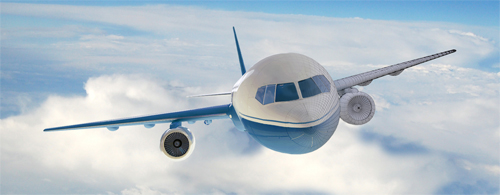
Компанія «ПРОГРЕСТЕХ-УКРАЇНА» є найбільш динамічно розвивається частиною групи компаній ПРОГРЕСТЕХ. Створена в 2007 році з метою збільшення обсягів інженерно-сервісних послуг і залучення додаткових ресурсів в країнах СНД. Основний напрямок діяльності - інжинірингові та консультаційні послуги в галузі авіабудування і технологій аеропортів.
У 2008 році відкрито філію компанії в м.Харкові.
Основний напрямок діяльності компаній - інженерні послуги в галузі авіабудування і технологій аеропортів
Компанія постійно вдосконалюється і розвивається. В роботі використовуються сучасні підходи до менеджменту, власний науковий і виробничий досвід, працює висококваліфікований і компетентний персонал.
Інженерні сервіси:
Компанія ПРОГРЕСТЕХ-УКРАЇНА активно розвивається. В даний час в компанії працюють понад 130-ти чоловік. Середній вік працівників 30 років. Серед них як вчорашні студенти, так і досвідчені фахівці, які мають різні наукові ступені і звання. Багато хто починає працювати в компанії будучи студентами, набуваючи практичний досвід, а закінчивши ВНЗ, приходять в УКР-ПРОГРЕСТЕХ на постійну роботу. У нас працюють випускники КПІ ім. Ігоря Сікорського та багатьох інших навчальних закладів України.

Програми професійного розвитку персоналу включають постійне підвищення кваліфікації всіх співробітників, освоєння нових професій шляхом отримання другої вищої освіти, отримання вчених ступенів, придбання досвіду роботи в компаніях світового рівня.
Прогрестех-Україна - http://www.progresstech.com.ua
Кафедра Динаміки та міцності машин та опору матеріалів тісно співпрацює з компанією «Boeing»
На базі кафедри Динаміки і міцності машин та опору матеріалів створин Спільний навчально-науковий центр «КПІ ім. Ігоря Сікорського» та компаній «Boeing» і «Прогрестех-Україна».




Корпорація «Boeing» є провідним виробником цивільних і військових повітряних суден, а також оборонних, космічних систем і систем безпеки. Вона співпрацює з урядами США і дружніх держав, а також авіакомпаніями в більш як 150 країнах світу.
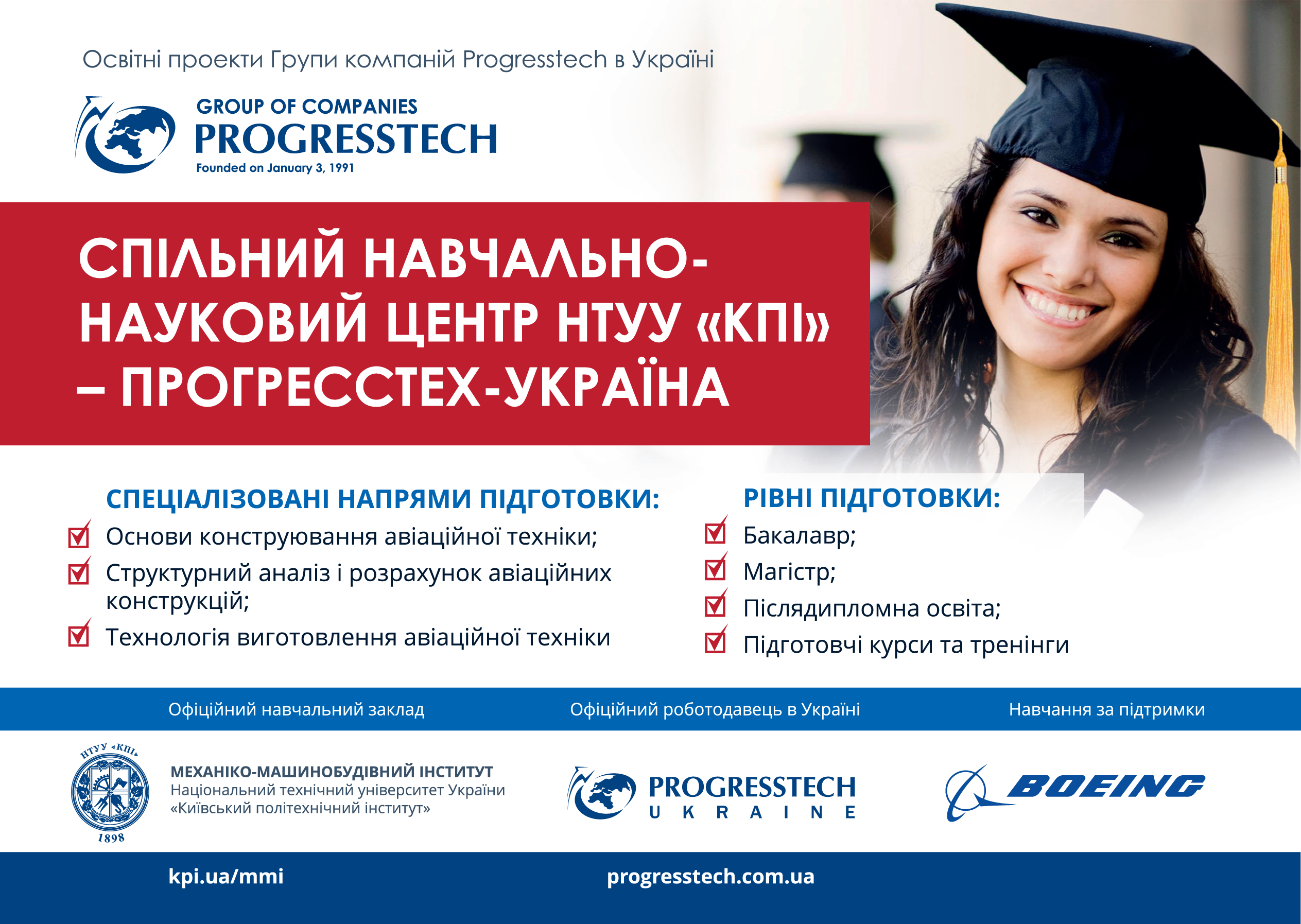

ISSN 2409-5966 (Online),
ISSN 2305-9001 (Print)
The Handbook is included into the list of scientific specialized editions of Ukraine and reviewed in the reviewing magazine VINITI RAN (Moscow, Russia), reviewing magazine Dzherelo (Kyiv, Ukraine).
Electronic edition of the magazine is saved in the V. I. Vernadskiy National Library of Ukraine.
The Handbook is included in the state reviewing database "Ukrainika Naukova" and international scientific databases Google Scholar, RINC (eLIBRARY.RU).
An acquaintance with the newest achievements in the branch of mechanical engineering, the results of scientific achievements and improved methods of calculation and planning of elements in mechanical engineering constructions.
For scientists and scientific and technical specialists in the branch of mechanical engineering.
Materials of the articles are presented in the release of authors. The articles are reviewed.
State registration certificate of the printed medium of communication series KB №17906-6756PR from 17.05.11
The journal is registered in the List of specialized editions pursuant to the Decree of Ministry of Education and Science of Ukraine № 1279 of 06 November, 2014
Founded in 1964
Periodicity: 3 times a year
Language of edition : Ukrainian, Russian, English, German (by the mixed languages)
Journal of Mechanical Engineering the National Technical University of Ukraine "Kyiv Polytechnic Institute" is included in the catalog of Ukraine.
Subscribe to it can be in local offices.